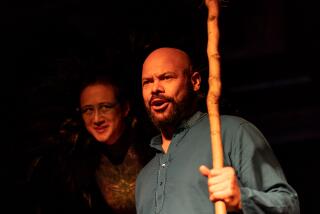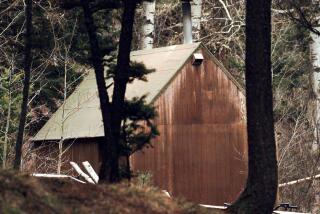SHAH OF SHAHS <i> by Ryszard Kapuscinski, translated from Polish by William R. Brand and Katarzyna Mroczkowska-Brand (Harcourt Brace Jovanovich/a Helen and Kurt Wolff book: $12.95; 152 pp.) </i>
- Share via
This supercharged particle of a book uses a kind of black light. It obscures many of the base lines and connections that we expect in a work of reportage and eerily brings out things that fall between the lines of even the most sensitive and adventurous journalistic writing.
The author, who several years ago produced a haunting account of the decaying years of Haile Selassie, emperor of Ethiopia, has ventured into another cycle of decay and cataclysmic eruption. “Venture” is the wrong word. Ryszard Kapuscinski whizzes through the downfall of the Shah of Iran in 150 pages, short-cutting his way from one idiosyncratic vantage point to another, producing sometimes a blur and sometimes a striking revelation.
Kapuscinski is a journalist employed until 1981 by the Polish Press Agency. PAP, as the Polish acronym goes, is a menagerie of bureaucratic officialism, individual eccentricity and irregularly brutalized talent. The tiger keepers and the tigers inhabit the same cage and, as Western correspondents have learned, one should make no assumptions at all about what to expect of a PAP-person met in a Third World bar or sharing a cheap ride across a savanna.
“Shah of Shahs” is unexpected, certainly; strikingly successful at times in its compression, and at other times, maddeningly vague. At its best, it gives an extraordinary sense, not so much of what happened at various points of Iran’s difficult history as of how it felt. It mixes factual anecdotes with a few that, however attractive, seem unverifiable. (Did the shah’s sister really pour caustic soda into his first wife’s milk bath?) Kapuscinski’s sources are not merely unnamed, which is reasonable, but unpersonified. He appropriates them; it can be hard to know if the author has thought himself into his anonymous Iranians’ minds or if he has drawn the Iranians into his own.
One of Kapuscinski’s strengths is his vivid use of history to clarify principal themes in what came across to us so often as a blur of shouting mobs, bearded mullahs and short takes about the shah’s extravagance and the bestiality of SAVAK, the secret police.
He begins, in fact, by commenting on a series of photographs. One shows the shah’s grandfather, an ordinary illiterate soldier deputed to conduct a previous, deposed shah across Persia--he holds him by a chain--to his execution in Tehran. The soldier’s son, Reza Khan, becomes an officer and leads a coup in 1921 that makes him shah.
In the description of Reza Khan’s brutal drive to enrich himself and modernize his country, we obtain a perspective on his own son who for all his 30 years in the limelight, never quite came into focus. Reza Khan bombarded mosques and had his police brutalize women who wore the chador. It gives us an illuminating image of the pendulum that was to bring the ayatollahs out of the mosques and brutalize the women back into chadors.
Kapuscinski’s succinct and vivid account of the Shia sect and its traditional insurrectional temper makes a framework of harshness and extremity for the roiling extremities of the Khomeini uprising. The history of the town of Kerman, whose children were blinded by an earlier shah and who wandered around the countryside relating the atrocity, prepares us to read about the SAVAK’s tortures and see them not as unimaginably horrible but, far worse, imaginably so.
He is equally lucid and succinct on the tremors of protest, led by the mullahs, that unseated the shah and about the shah’s own vacillations that fed them. He pinpoints the 40-day harmonic. Forty days after a death, the Shias have the custom of gathering to remember the dead and, if the death was violent, to think of revenge. Forty days after the massacre at Qom, the crowds gathered to remember at Tabriz. The police opened fire. Forty days later, they had to open fire at Isfahan, then at Meshev, then in Tehran.
As Kapuscinski sweeps through the reign of the last shah, the high colors of his writing sometimes smear. An account of the extravagances and mistakes made in the effort to industrialize is punctuated repeatedly with sardonic, parenthetical interjections of “The shah hadn’t realized.” The description of the atmosphere of fear created by the SAVAK has a rhetorical quality that overpowers its striking detail.
Kapuscinski’s efforts to personify life under the shah are hampered by the vague attributes of those he writes about. A whole section is devoted to the travails of Mahmud, an intellectual who returns from London in the late ‘70s and finds himself in nightmare country. The nightmare is undoubtedly real, but Mahmud is impalpable and has the feel of a composite.
The author’s method is to imagine himself into reality. This risks making the real seem imaginary. But, when it works, it is splendid. He thinks about the individual members of the mobs, and suddenly the mobs themselves seem real to us. He portrays Razak, a baker’s assistant who quits the job every so often because he cannot bear being away from the village where his family lives. In the village there is nothing to eat, and Razak has to return to Tehran to find still one more menial job. In a phrase, Kapuscinski lights up the hopeless cycle of life for the impoverished on our planet.
“Right next to Razak, there is the great world of the shah, the revolution, Khomeini and the hostages. Everybody is talking about it. Yet Razak’s world is even bigger. It is so big that Razak roams around it and can’t find a way out.”
For all his swoops and colors, Kapuscinski can be quietly lucid, as he is in his discouraged meditation on the failure of the Khomeini revolution to work on the roots of Iran’s misery. The shah’s grandfather came from a village; so did the mullahs’ followers, directly or indirectly. There will always be the energy of outrage to bring people in to overthrow oppression, and then, without skills, they will repeat the mistakes of the oppressors. Not until the villages themselves are developed will “the spellbound circle of helplessness be broken,” Kapuscinski writes. “As long as the son who has moved to the city visits his native village a few years later as if it were some exotic land, the nation to which he belongs will never be modern.”
More to Read
Sign up for our Book Club newsletter
Get the latest news, events and more from the Los Angeles Times Book Club, and help us get L.A. reading and talking.
You may occasionally receive promotional content from the Los Angeles Times.








